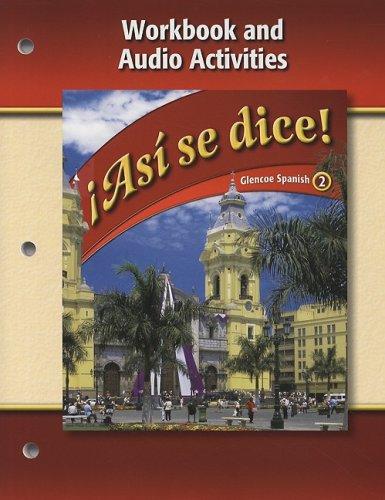
All Solutions
Page 6: Vocabulario 2
According to the context of the sentence, the right word to complete with is ***tomó*** (took) which is the past simple of the verb ***tomar*** (take) of the third-person singular.
Ella **tomó** las fotos con su cámara digital.
*(She took the photos with he digital camera.)*
According to the context of the sentence, the right word to complete with is ***bajó*** (in this context means downloaded) which is the past simple of the verb ***bajar*** (to download) of the third-person singular.
Entonces ella **bajó** las fotos en su computadora.
*(She then downloaded the photos to her computer)*
According to the context of the sentence, the right word to complete with is ***asignó*** (assigned) which is the past simple of the verb ***asignar*** (to assing) of the third-person singular.
Ella **asignó** diferentes timbres a sus mejores amigos.
*(She assigned different ringtones to her best friends.)*
According to the context of the sentence, the right word to complete with is ***Contestó*** (answered) which is the past simple of the verb ***contestar*** (to answer) of the third-person singular.
**Contestó** su móvil.
*(She answered her mobile.)*
According to the context of the sentence, the right word to complete with is ***decolgó*** (picked up) which is the past simple of the verb ***descolgar*** (to pick up) of the third-person singular.
Ella quería hacer una llamada telefónica y **descolgó** el auricular.
*(She wanted to make a phone call and picked up the handset)*
According to the context of the sentence, the right word to complete with is ***intrudujo*** (inserted) which is the past simple of the verb ***introducir*** (insert) of the third-person singular.
**Introdujo** su tarjeta telefónica en la ranura.
*(She inserted his calling card into the slot.)
According to the context of the sentence, the right word to complete with is ***sonó*** (rang) which is the past simple of the verb ***sonar*** (to ring) of the third-person singular.
**Sonó** el tono.
*(The tone rang)*
According to the context of the sentence, the right word to complete with is ***marcó*** (dialed) which is the past simple of the verb ***marcar*** (to dial) of the third-person singular.
**Marcó** el número que deseaba.
*(She dialed the number she wanted.)*
According to the context of the sentence, the right word to complete with is ***esperó*** (waited) which is the past simple of the verb ***esperar*** (to wait) of the third-person singular.
Su amigo **esperó.**
*(Her friend waited.)*
According to the context of the sentence, the right word to complete with is ***cortó*** (cut off) which is the past simple of the verb ***cortar*** (cut) of the third-person singular.
Desgraciadamente, se les cortó la línea.
*(Unfortunately, their line was cut off.)*
This information is true, so we will choose Sí *(yes)*.
This information is true, so we will choose Sí *(yes)*
This information is false, so we will choose No *(no)*
This information is false, so we will choose No *(no)*.
This information is True, so we will choose Sí *(yes)*.
Sí, tengo un teléfono.
*(Yes, I have a cellphone).*
Lo uso para comunicarme con mis familiares, amigos y para navegar por internet y tomar fotos.
*(I use it to communicate with my family, friends, to surf the internet and take photos).*
Mi número de teléfono es 041491502251
*(My number phone is 041491502251)*
Sí, tienen un teléfono en casa.
*(Yes, they have a phone at home)*
Su número es 02391112525
(Their phone number is 02391112525)*
El código de área es 0239
*(The are code is 0239)*
Sí, realizo muchas llamadas de larga distancia.
*(Yes, I make a lot of long distance calls).*
*(Hello? Can I talk to .. (name))*
*(Hello! How have you been?)*
*(I’m calling for …)*
*(How is everything going?)*
*(I can’t talk right now, I’ll call you later)*
*( I have a missed call from this number)*
*(It was good talking to you, bye.)*
*(Thanks for calling, see you)*

